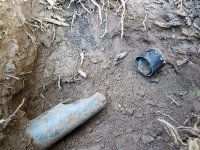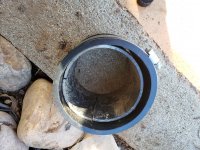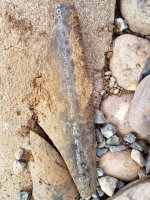BoarFart
New Member
I live at the bottom of a big hill with numerous homes above me. On Thanksgiving we had a heavy rain event and water started coming up out of the ground where I am pointing in the pictures below. It overflowed and completely ruined my pool water and then began to pool up on the side of my house and risk flowing underneath through the vent holes. I dug down and discovered this random blown out ABS pipe that is coming from some other property behind me and continuing down the side of my yard to an unknown area. It is not sewer, it has no odor and only flows water during heavy rain events.
I have spoken with the neighbors and nobody can figure out where it's coming from. I had the line scoped and there is a blockage roughly 15' in both directions, so I can't follow it any further. I want to seal this line of completely and not take all of this water from my neighbors through my property. My issue is that this pipe measures 4" but current 4" ABS caps are too big. This pipe is much more thin, which is why the caps are not fitting snug. My house was built in the late 50's, so I would imagine this pipe is quite old. I have thought about tightening down a Fernco test cap, but I do not feel that will be a permanent fix with the head pressure created from the water. I have been to every plumbing store in town and can't seem to find a fix.
The local Fernco waterworks recommended I get two 4" flexible couplings and repair the pipe. My concern there is that due to the blockage in the line, the pressure will eventually build up with no outlet and I don't think these couplings will be able to hold given the size variance. This is why I just want to cap it and be done. I'm ready to shove some foam sealant in there, concrete, anything that can permanently plug this line. Any help will be greatly appreciated.
I have spoken with the neighbors and nobody can figure out where it's coming from. I had the line scoped and there is a blockage roughly 15' in both directions, so I can't follow it any further. I want to seal this line of completely and not take all of this water from my neighbors through my property. My issue is that this pipe measures 4" but current 4" ABS caps are too big. This pipe is much more thin, which is why the caps are not fitting snug. My house was built in the late 50's, so I would imagine this pipe is quite old. I have thought about tightening down a Fernco test cap, but I do not feel that will be a permanent fix with the head pressure created from the water. I have been to every plumbing store in town and can't seem to find a fix.
The local Fernco waterworks recommended I get two 4" flexible couplings and repair the pipe. My concern there is that due to the blockage in the line, the pressure will eventually build up with no outlet and I don't think these couplings will be able to hold given the size variance. This is why I just want to cap it and be done. I'm ready to shove some foam sealant in there, concrete, anything that can permanently plug this line. Any help will be greatly appreciated.









